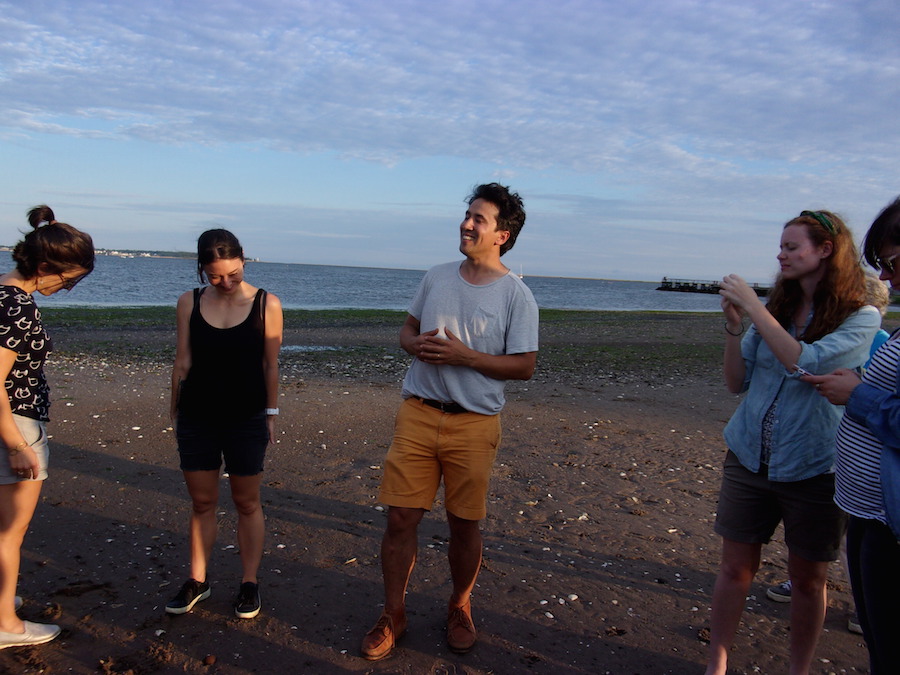
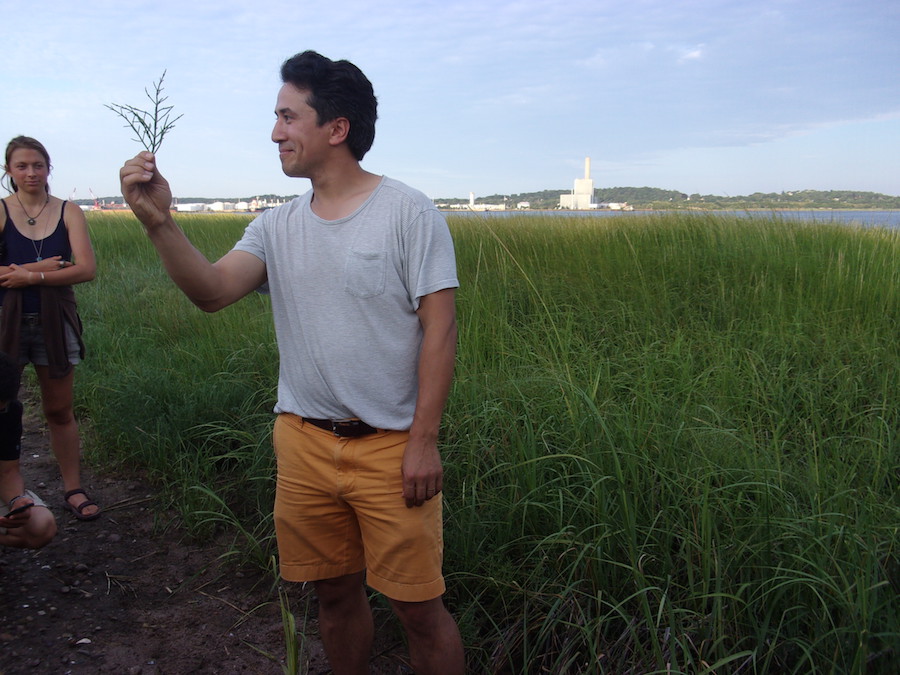 Justin Freiberg raises a spring of glasswort, which he and his friends grew up calling a "pickle plant" for its salty taste. Leah Andelsmith Photos.
Justin Freiberg raises a spring of glasswort, which he and his friends grew up calling a "pickle plant" for its salty taste. Leah Andelsmith Photos.
Standing on a sandy trail with the sea grass waving around me, I breathed in the salty air coming off of New Haven Harbor and took in the view of the Q Bridge and the Gulf Oil storage tanks. I held a tender, green stem of glasswort, a plant I had learned about for the first time just moments before. Technically, the plant is edible and possibly even tasty. I could eat it. But it had been covered in harbor water at high tide just a few hours before. Did I want to take that risk?
On Tuesday night, the New Haven Land Trust offered “Eating Wild at Long Wharf,” a free, hands-on workshop about foraging for edible plants. Several dozen attendees convened just before sunset at the Long Wharf Nature Preserve to get an introduction to wild, urban edibles from Justin Freiberg, director of the Yale Landscape Lab and Vice President of New Haven Land Trust’s Board of Directors. Tracker and wildlife educator Andy Dobos and New Haven
Land Trust intern Nina Campbell were co-leaders for the event, which brought in more than four dozen attendees.
Gathered in a circle at the trailhead, Freiberg set the stage for our journey through the preserve. He reminded us about the industrial use of the area and the heavy metal contaminants that go along with it, and said he would show us the plants that are safer to eat. He also explained the concept of responsible foraging—harvest some, leave most.
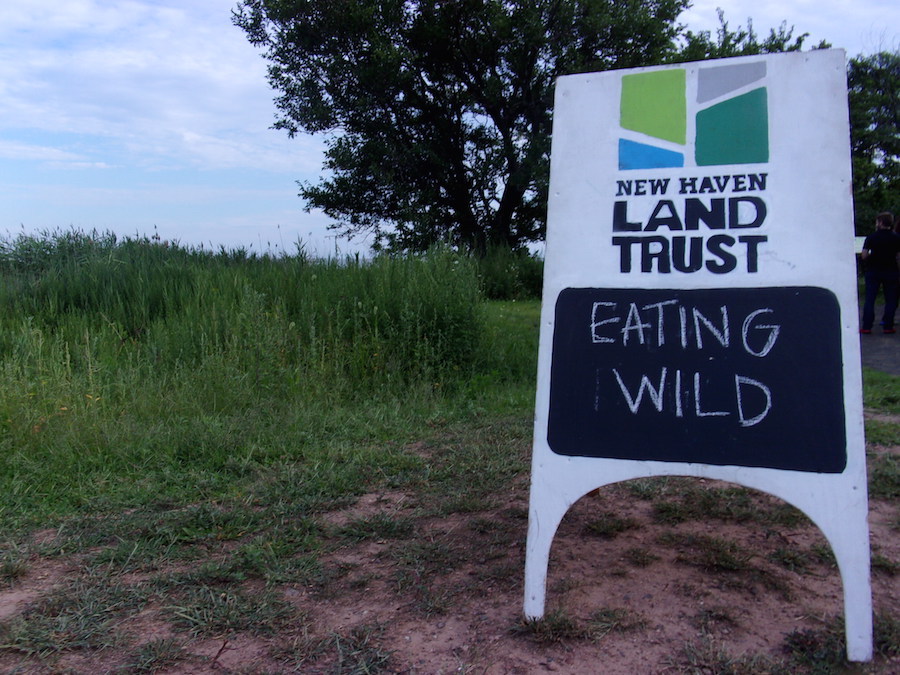
“Learn here, forage elsewhere” is the best bet for edibles, he advised the group.
Before we got on the trail, Freiberg showed us half a dozen wild edibles thriving just a few yards from the parking lot. There was a salty breeze and green plants all around, which contrasted sharply with the noise of Interstate 95 in the background.
He pointed out a Japanese knotweed, a plant that is a bit like rhubarb and from which you can make a compote from the tender shoots.
“When you see one of these, take note of where it grows,” he said. “Then, come back in the spring to harvest the plant while it’s young.”
In the fifties, foragers boiled everything in three changes of water before frying it up with bacon and onions, said Freiberg. Today’s foragers are a bit more adventurous.
Freiberg bent down to pick a sprig of pepper grass before offering us the tiny seed pods to eat. “I’m at a ten out of ten comfort level with eating this plant,” he said.
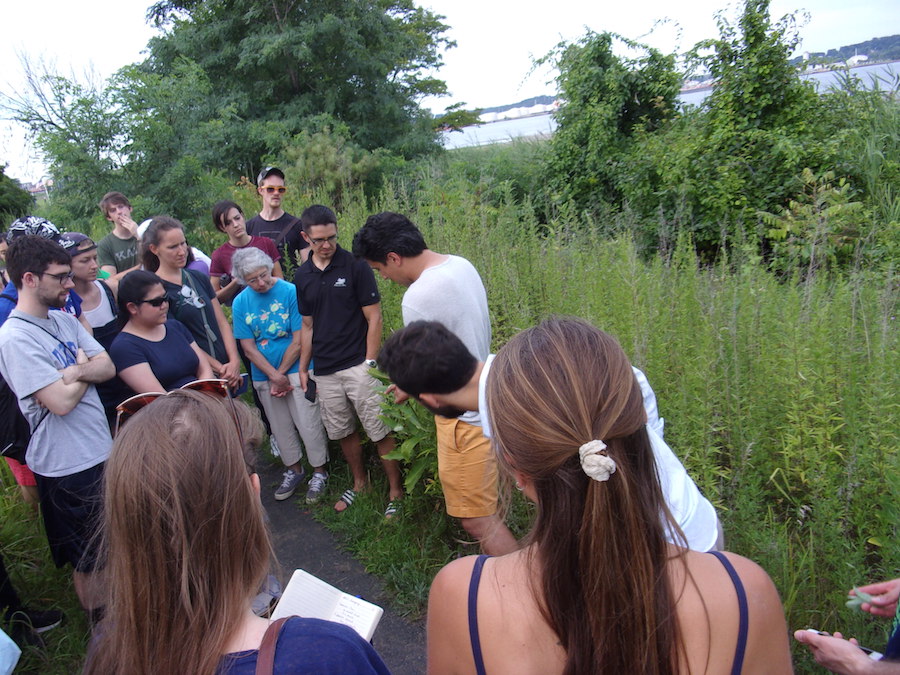 In front of milkweed on the trail.
In front of milkweed on the trail.
I took one into my palm—pale green in color and the size and shape of an eggplant seed. I put it in my mouth and crunched it between my front teeth. It tasted like radish and arugula.
Knowledge like Freiberg’s is built “bit by bit” with lots of practice, and rounded out with deep study of trusted books and reputable resources. About the worst thing you can do, he said, is google “peppergrass edible” and trust the first link that says you can eat it. Would-be urban foragers need to be thorough and do their homework.
He showed us lamb’s quarters, a plant with small, spade-shaped leaves the color of comfrey. It’s edible raw, but Freiberg prefers to cook it first, “like swiss chard,” he said.
People took their phones out to get close ups of the plants being passed around. They stepped forward to get shots of the plants in situ. Someone interrupted excitedly with a question.

We started down the trail, but stopped within a minute or two at a milkweed plant.
This is one I knew from butterfly gardens: monarchs lay their eggs on these plants and the resulting caterpillars feast on them. But Freiberg surprised me when he said that humans can also eat young milkweed pods—in late June and early July, when they’re first coming out.
We tramped just a few steps off the path through a patch of mugwort to a juniper tree. The base of gin, juniper berries can be steeped in vodka and the fronds can be used on the grill to add a smokey flavor to food. Freiberg passed around a small stem for us to sample.
The scent of juniper is like pine, but with a bit of the desert in it. There’s something dry and weathered about the aroma. The berry tasted remarkably like gin, but also herby and spicy, “like chewing a peppercorn,” Freiberg said. The taste is complex and Freiberg thinks it has culinary value.
“Think of how you could use that flavor,” he said.
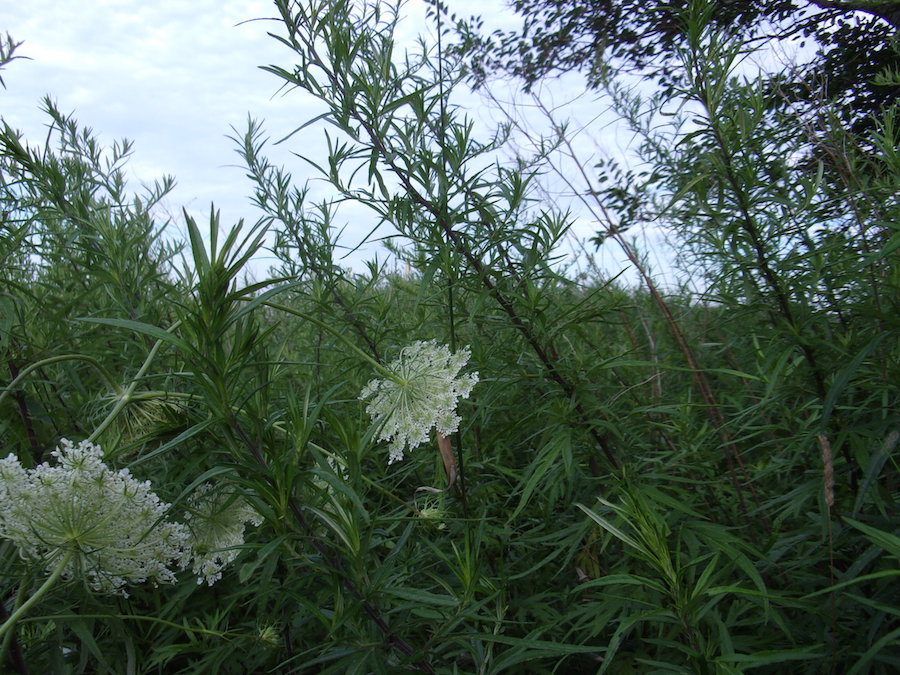
Freiberg pointed out that the same way one apple might be sweeter or juicier than another, different individual plants of the same species can have different tastes. “If one plant tastes bad to you, try another,” he said.
Plants can also look slightly different, depending on growing conditions. “I identify mugwort by the smell,” he said before encouraging us to pick some of the invasive species from the patch we were standing on. “They don’t need anymore of it around here.”
The woman next to me reached out and broke the top off of one of the stalks. She smelled it and then gave a bit to her friend behind her before handing some to me.
“It doesn’t have much of an odor,” she reported. I rubbed the jagged leaves in my palms, trying to release the oils before I gave it a sniff. It’s like sage, but not as strong.
“That’s it exactly!” she said.
Our next stop was a juneberry tree, which grow really well in the Northeast, including in downtown New Haven. Two weeks ago, when this program was originally supposed to take place but was rained out, the tree was covered in fruit. “It’s like a better blueberry,” said Freiberg.
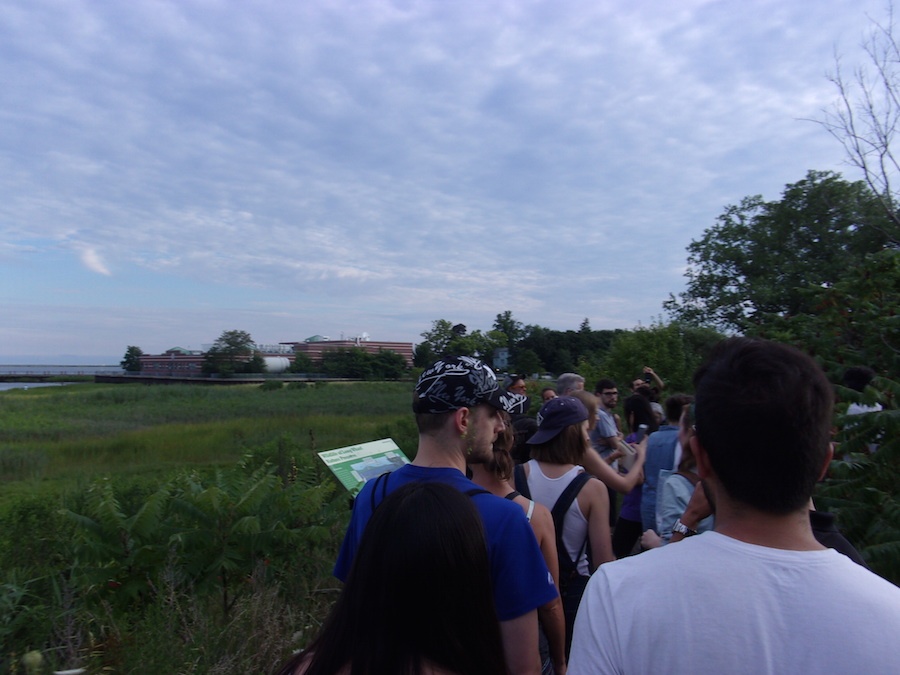
We crowded down the trail and people struck up conversations with each other. Others pointed and talked animatedly, noticing different plants along the trail. Someone picked a few leaves of something and at the next stop, Freiberg gave us an impromptu lesson. Was this plant related to cilantro? Parsley? Wild carrot? All those are edible, but the unassuming bit of greenery looked too close to water hemlock—the poisonous plant that killed Socrates—for Freiberg’s taste.
Standing under a staghorn sumac tree, Freiberg explained that it was very different from poison sumac, which grows mainly in swampy areas. Staghorn sumac has fuzzy flowers in a deep, burgundy color. We touched the tiny hairs on a couple of the freshest-looking blooms, then licked our finger tips. The taste was pleasantly sour and subtle.
Picking a sprig of Russian Olive, Freiberg told us that if we come back in early fall, the berries—now just tiny buds—will be big and ripe and we could harvest and mash them to make fruit leather.
That was when it hit me: the real goal of this program is to get us coming back year round, so we can develop a relationship with the land and with these plants. Freiberg said he hopes people will get “a prolonged curiosity” out of the session.
“That people want to continue to explore this idea,” he said of his hopes for the session. “That they see nature and the environment around them as having potential.”
.jpg) Sumac.
Sumac.
Even in the middle of a city. Especially in the middle of a city.
We crossed a small footbridge and the tree-lined, gravel trail turned to sand and sea grass. Freiberg stopped the group to show us beach orache.
“Does that look familiar to anyone?” he asked. “It looks like lamb’s quarters,” someone called out, remembering the plant we saw earlier on the trail. Freiberg said he’d had a taste of it earlier, and if you’re picnicking on the beach, it goes great with salad or shellfish.
But this area gets inundated by New Haven Harbor water, he pointed out next. It’s what makes the plants salty. A few people picked leaves off of the small stem he passed around. I let it pass right by me. Absolutely not, I thought. No way would I try something that has been touched by harbor water.
As we headed back to the trail head, the sunlight was painting the tips of the grasses yellow-green, and the marshy, salty, low tide smell intensified. A container ship was anchored in the harbor. Freiberg stopped in front of a low plant that looked like a spindly cactus.
“Did anyone eat this as a kid? What did you call it?” he asked. He said that he and his friends used to call it “pickle plant,” because it tastes salty and sour, like a dill pickle. Its more common name is glasswort. Folks gathered in close to pick a sprig of their own.
I imagined the whole area under murky water. Nope, I thought. No matter how much you like pickles, this is something you just can’t eat. But others in the group were trying it. And they liked it.
“Oh my god, this plant is so salty. I love it!” one person gushed. My curiosity was killing me.
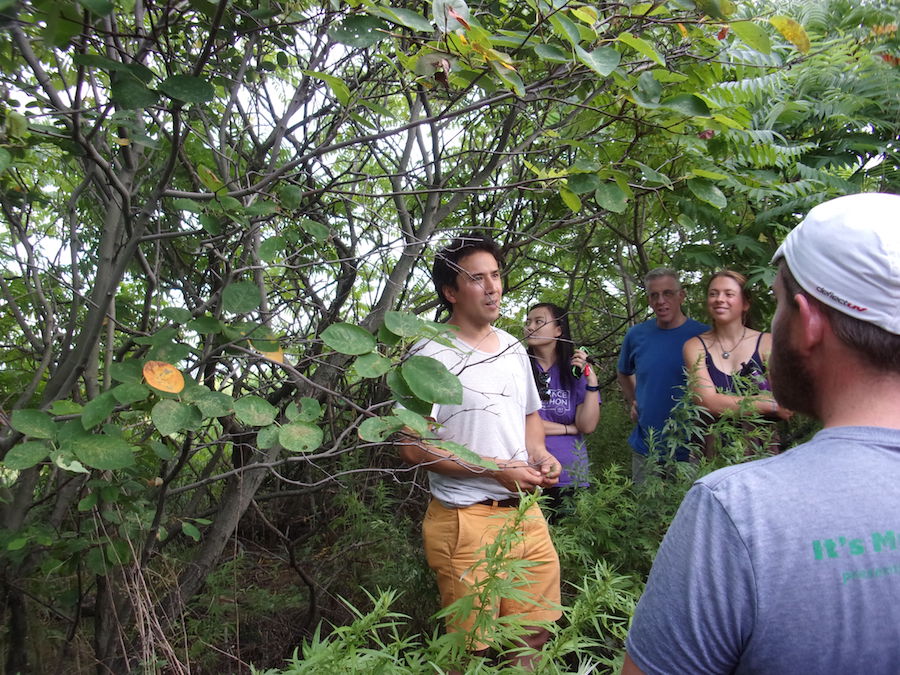
I had a tiny piece of the pickle plant in my thumb and forefinger. It was a deep green, fleshy and soft, and it burst when I experimentally dug my nail into it. “Like a succulent,” someone near me was saying.
Finally, my FOMO—fear of missing out—kicked in and I popped a centimeter-long tidbit into my mouth before I could think any more about it. It was a little salty, a little crunchy, a little juicy—just like a pickle—and it was part of the adventure.
We took the last bit of trail and wound up on open sand flats right next to the water, where we took a break next to a patch of neon-green leaves wilting among the shells—sea lettuce. People were happy, jazzed to be tasting new foods and making new friends.
Back at the trailhead, we lined up to get a couple sips of the “pink lemonade” made from staghorn sumac. A New Haven Land Trust intern opened the top and a half dozen people took a giant step forward all at once to peer inside. I got a peek too: sumac flowers wrapped in cheese cloth, which had been steeped in warm water and then cooled. It was mildly refreshing, like water with a squeeze of lemon. “I’d drink this,” said one of my enthusiastic neighbors.
The walk now over, a few people immediately started off down the trail again, likely hoping to harvest some plants or practice their identification skills. Conversations that had started earlier in the evening with “so you work at…” got a little deeper. A trio of new friends chatted about New Haven’s “bubbles.”
“Sometimes people from one bubble show up in another,” one said. “I’m glad to be in your bubble now,” another responded. People smiled and said goodbye as they left.
The evening was also personal for Freiberg, who said that the tangibly rewarding part of this work is developing a closer relationship with the plants in your area, being able to pick them out individually instead of just seeing a wash of green.
“It’s about seeing more patterns than I would otherwise see,” he said.

